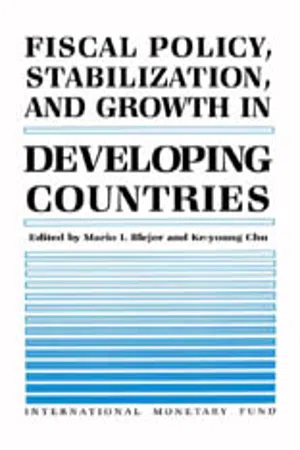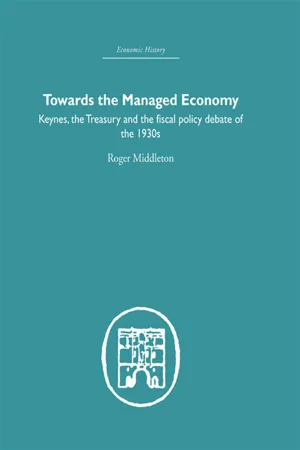Cyclically Adjusted Budget Balance
The Cyclically Adjusted Budget Balance is a measure that accounts for the impact of economic cycles on government budgets. It adjusts the actual budget balance to reflect what the balance would be under normal economic conditions, thus providing a more accurate assessment of fiscal policy. This helps policymakers make informed decisions by separating the effects of the business cycle from underlying fiscal trends.
3 Key excerpts on "Cyclically Adjusted Budget Balance"
- eBook - ePub
- Anthony J. Makin(Author)
- 2016(Publication Date)
- Routledge(Publisher)
...This is because government revenue, especially income taxes as well as indirect taxes on goods and services, is procyclical. It rises and falls in line with domestic economic activity and the business cycle. Meanwhile, government transfers in the form of unemployment benefits are anticyclical, rising during downturns in the economy and falling during upturns. This suggests that budget balances can be adjusted for cyclical influences, as conveyed in Figure 7.1. Other things being equal, the higher the level of economic activity, the higher is government revenue and the lower are transfers. Hence the BB schedule is positively related to national income, as shown by the upward slope. If the economy were at less than full employment at Y E, there would naturally be a budget deficit, owing to lower than normal tax revenue and higher than normal spending. As the economy moves from the trough to peak of the business cycle, employment increases, automatically yielding a budget surplus at Y F. The implication is that actual budget deficits should not be a policy concern, in and of themselves, since they reflect underlying macroeconomic conditions. However, this assumes that public debt, which budget deficits add to, is at a sustainable level. What debt sustainability means is explained later in this chapter. FIGURE 7.1 Economic activity and the budget balance Governments have actively used budgets as a policy instrument in the post-war years to counter the business cycle, with the fiscal stance becoming expansionary during recessions and contractionary during economic booms. Open economy factors have also motivated fiscal policy. For instance, the so-called twin deficits hypothesis, relating the public accounts and the external accounts (to be outlined shortly) justifies using fiscal contraction to reduce current account deficits. Almost all government decisions, whether they relate to policies as diverse as defence or the environment, have budgetary implications...
- INTERNATIONAL MONETARY FUND(Author)
- 1989(Publication Date)
- INTERNATIONAL MONETARY FUND(Publisher)
...If none of these is true, deterioration in the current account balance may be attributable to private sector demand or to other factors. The approach considered to determine the stance of fiscal policy involves adjusting the actual fiscal balance for cyclical effects in an effort to obtain a cyclically neutral measure of the budget balance. The summary measure used in this section was originally proposed by the German Council of Economic Experts and employed in the Fund’s World Economic Outlook (1985). 12 The actual budget balance (B t) may be decomposed into a cyclically neutral component and the expansionary or contractionary fiscal stance (FIS t): where t 0 = TQ/Yq, base-year ratio of tax (t 0) to GNP (Y 0) g 0 = G 0 / Y 0, base-year ratio of expenditure (G 0) to GNP Y = actual output in nominal prices Y P = potential output in nominal prices T = government revenue FIS = fiscal stance measure The first two terms in equation (7) —normal balance and cyclical components—can be merged to define the cyclically neutral balance; the actual deficit in excess of the cyclically neutral deficit is deemed expansionary, relative to the base-year fiscal stance. To determine if the thrust of fiscal policy has been more expansionary relative to the previous year, the fiscal impulses (FI) may be examined by taking the first differences of the fiscal stance measure: The expansionary or contractionary nature of total budgetary expenditure and its components are also examined. Government expenditure is termed cyclically neutral if it increases proportionately with increases in nominal potential output; a more-than-proportionate increase is considered expansionary, and vice versa. III. C AUSALITY T ESTS FOR R ELATIONSHIP B ETWEEN B UDGET D EFICIT AND C URRENT A CCOUNT D EFICIT OF B ALANCE OF P AYMENTS The causality test used in this paper is based on the method developed by Pierce (1977) and Pierce and Haugh (1977)...
- eBook - ePub
Towards the Managed Economy
Keynes, the Treasury and the fiscal policy debate of the 1930s
- Roger Middleton(Author)
- 2013(Publication Date)
- Routledge(Publisher)
...A balanced budget therefore meant that G c should not exceed T c. The definition of the budget used in this study is: where B is the budget balance and where T c and G c are as before, and NRT = non-recurrent revenue included in T c SIFPC = private sector contributions to the social insurance funds CE = capital expenditure financed by borrowing OB = other expenditure financed by borrowing DB = defence expenditure financed by borrowing SF = sinking fund payments included in G c SIFB = total benefits paid by the social insurance funds SIFGC = central government contributions to the social insurance funds included in G c. These adjustments serve two purposes. First, they revise the coverage of the central government accounts so that they conform more closely to those now currently in use. Secondly, they remove the effects of fiscal window-dressing: that is, the exclusion of non-recurrent receipts and the inclusion of various items of expenditure financed by borrowing nullifies the accounting devices employed by the Treasury to aid the achievement of a target balance B c. 2 FISCAL WINDOW-DRESSING Table 5.1 records the conventionally defined budget balance (B c) and the adjustments made to expenditure and revenue as part of the procedure for obtaining an unchanging, and economically more significant, definition of the budget (B). As above, these adjustments can be considered in two stages. The exclusion of sinking fund payments and extension of the budget definition to incorporate fully the social insurance funds requires little comment. Its effects are clear: the budget balance is improved in the case of the former; whereas, in the case of the latter, the balance of the social insurance funds could, at certain times (for example, 1929–31 when unemployment was rising rapidly), have important consequences for budgetary stability. Prior to 1937 fiscal window-dressing on both sides of the budget accounts was small in magnitude at less than 1 per cent of GDP...


